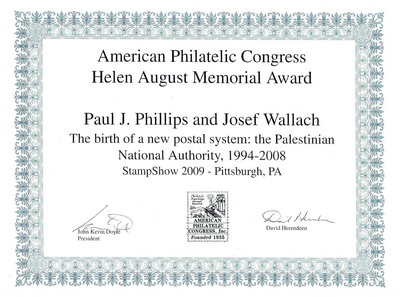UNDERCOVER (CLANDESTINE) MAIL BETWEEN ISRAEL & ARAB COUNTRIES AFTER 1967
Click on pictures to enlarge !
Introduction
Following the war of 1948, Arab countries boycotted the newly formed state of Israel including its postal services, severing all postal connections. Letters routed to Israel or the Arab states were returned, bearing cachets such as "Pas de service", "Pas de service via Israel" and "Pas de relation avec Israel". The Six-Day war commenced on June 5, 1967. By the end of June 1967, the Gaza strip, Sinai, the West Bank (Judea & Samaria) and the Golan Heights were held by Israel. At the declaration of ceasefire, thousands of Arab inhabitants (mainly in the Gaza Strip) were separated from their relatives in Arab states. Most families had sons, brothers, parents and other relatives who immigrated to neighboring countries for economic and educational purposes. Commercial and postal relations were also severed and agricultural produce could no longer be transferred East. As in past disputes, the Red Cross intervened and supplied standardized forms that enabled delivery of short messages such as "I am well. So are the rest of the family members". This was a temporary and partial solution to the problem, and clearly could not replace regular postal connections.A. Clandestine Mail: Cover and Undercover - Mail via Third Country
The boycott being all-encompassing, one of the solutions for maintaining postal services between two parties was by sending mail indirectly via a third country. This option was known as undercover or clandestine mail. Nor was it a new solution; its precedents appeared during the First World War, and in larger scope during the second. The most famous WWII postal channel operated via the "Thomas Cook & Son Ltd." travelling agency in London through Portugal. In its role as official forwarding agent, and for the duration of hostilities, Thomas Cook & Son operated the famous postal address, PO Box 506, Lisbon, through which millions of letters between Great Britain and European countries under German occupation transited in both directions. The regulations governing the service were drawn up in 1940 by the General Post Office, but only reached final formulation in 1943. The following brief section is excerpted from the British Postal Master's instructions on forwarding mail to enemy states via a neutral country through Thomas Cook's agency. This classic example demonstrates how undercover mail was handled in various countries in during different periods.Conditions under which letters may be sent to relatives or friends in Enemy Countries or Enemy-occupied Territory:
1. Communications must be clearly written.. (without erasures)… and should not exceed two sides of a normal size sheet of notepaper. Only one letter may be placed in each envelope.
2. Letters and envelopes must omit the sender's address. They must only refer to matters of personal interest… (a) no reference may be made to any town (other than Lisbon), village, locality, ship or journey… No indication may be given that the writer is not in Portugal… (b) mention of a letter … received from or written to enemy occupied territory is not permitted…
3. Each letter must be placed in an open, unstamped envelope… fully inscribed to the addressee, who should be asked to address any reply to your full name, care of Post Box 506 LISBON, Portugal. Poste Restante addresses are not accepted…
4. The open envelope containing the letter should be placed in an outer stamped envelope and sent to THOS COOK & SON LTD., Berkeley Street, Piccadilly, London W.1., together with a memorandum plainly written IN BLOCK LETTERS containing in the name… and full address of the sender…
5. The communication to THOS COOK & SON LTD. must enclose a postal order value 2sh. which fee will cover the postage of one envelope containing one communication to the neutral country […] also of a reply (if any) from the neutral country to Messrs Cook's Head Office in London […]. For an extra fee of 6 pence each, letters can be sent Airmail between London and Lisbon.
6. Business letters […] must not be sent…
7. Communications for Prisoners of War [...] and Civilian internees cannot be sent under the foregoing arrangements […].
The above regulations published by the British Postal authority in 1943 interestingly reflect the process applied thirty years later between Israel and the Arab states following the 1967 war.
Transit Stages of Undercover Mail
Undercover mail always requires being diverted through a third, neutral country, and involves two phases:Phase 1:
The sender seals the letter in an envelope addressed with the final destination but having no stamps; then places it, together with payment for the rerouting service, inside another envelope addressed to a neutral, mediating body being either a post office or postal box in a neutral country.Phase 2:
The neutral, mediating body receives the mail addressed to it, opens it and forwards the internal envelope to its final destination by adding local postage. The envelopes scanned below exemplify the two-stage process: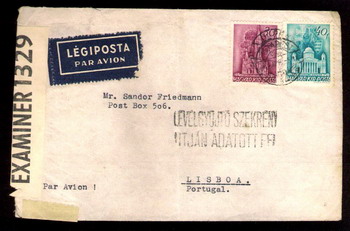
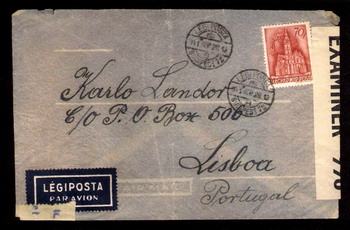
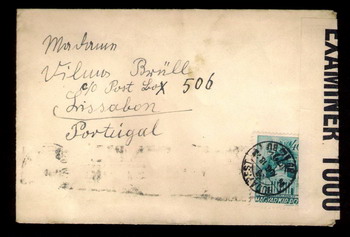
Figure A (Phase A) - sent in May 1942 from Hungary to POB 506 Lisbon, Portugal. The letters were received by the Thos. Cook agency in Portugal and forwarded to England for further handling.
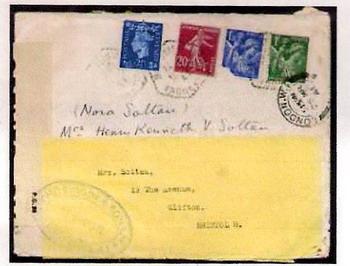
Figure B (Phases A+B) - sent in 1942 to POB. 506 Lisbon, Portugal. Thos. Cook Co. forwarded the cover to London, England. in this particular case, a yellow label with a new final destination was glued over the Lisbon address on the cover's front. The yellow band bears the oval stamp of the Thomas Cook Agency, tying the label to the cover. Phase B: In England a local King George 2½p. (blue stamp) is affixed. This clearly indicates the two-phase process. The above covers were offered at Sparks Auctions, November 2009. This idea was embraced by the postal authorities in the Mid-east where post was transferred via two main channels: (1) Via London, England, for the greater majority of postal volume. (2) Via Nicosia, Cyprus, in lesser quantities. Other marginally used routes are also described on this site.
B. The Open Bridge Policy - Mail Routing via the Jordan Bridges
Moshe Dayan, then the Minister of Defense, foresaw the problems arising from the separation of the Palestinian populations following the Six Day War of 1967. He formulated the "open bridge policy" for Allenby Bridge in the south, and Adam [Damiya] Bridge in the north. These bridges initially meant allowed exchange of goods between the West Bank and Jordan [the East Bank].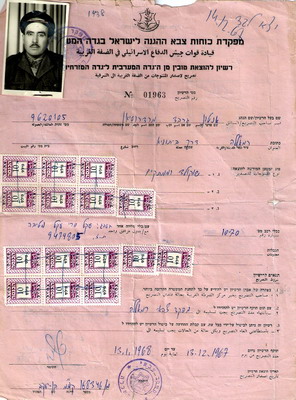
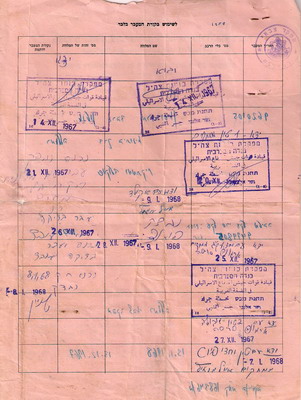
Jan.1968 "H.Q. Israel Defence Forces in the West Bank - permit to export goods from the West Bank to the East Bank " (quote) Multiple pass permit from Rammallah for export of " Chocolate and Sweets" . on rear Allenby Bridge custom station cachets .
Later this was expanded to include the passage of businessmen, tourists, and visitors. It was natural for people moving between the two countries to carry mail with them. Crossing into Jordan, individuals affixed the appropriate Jordanian postage stamps for addresses both within Jordan and to other Arab destinations. When crossing into Israel from the Jordanian side, things were handled differently. On the Israeli border of both bridges, Israel set up postal agencies with regular opening hours, where people could buy and affix Israeli stamps to the mail they brought with them from Jordan and other Arab countries. Outside of opening hours, the unstamped letters, addressed to people in Gaza, West Bank or Sinai were simply dropped into the postal agency mailbox. The next morning, the postal agent emptied the mailbox and sorted its contents. Mail with stamps was forwarded normally. Unfranked mail was dealt with according to standard procedures: it was stamped with the postal agency postmark, as well as a round, purple rubber "T" stamp indicating a "100% tax at destination" which was paid by recipient, a standard practice for any unfranked mail.
The next development in institutionalizing the sporadic mailing method occurred when Gaza Strip travel agents took over this activity, easily linking trips they arranged for clients with transfer of mail between their agencies on both sides of the border. They charged commissions for their services, in addition to the cost of postage stamps. [See interview with the head manager of a major Gaza travel agency]. Transfer of mail via the Jordan border bridges operated parallel to third-party (London, Cyprus etc.) postal contacts between Israel and Arab countries, and provided the residents of Gaza and the West Bank with postal solutions so satisfactory that in practical terms, it bypassed the mutual postal boycott between Israel and the Arab states to the point of rendering the boycott redundant. Once the Peace Treaties were signed with Egypt in March 1979, and with Jordan in October 1994, mail could be officially directed via Arab countries and these options were reduced substantially and eventually phased out altogether.
